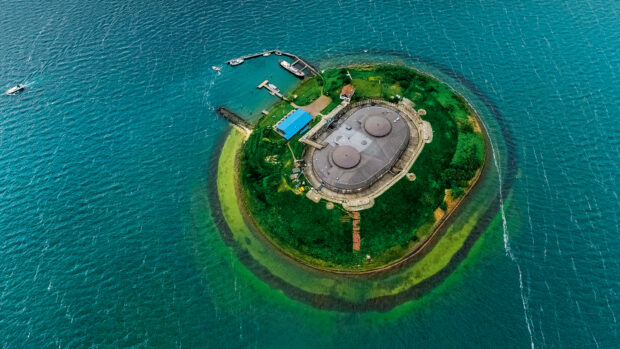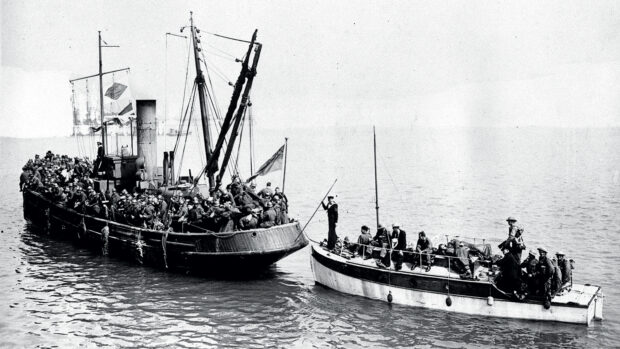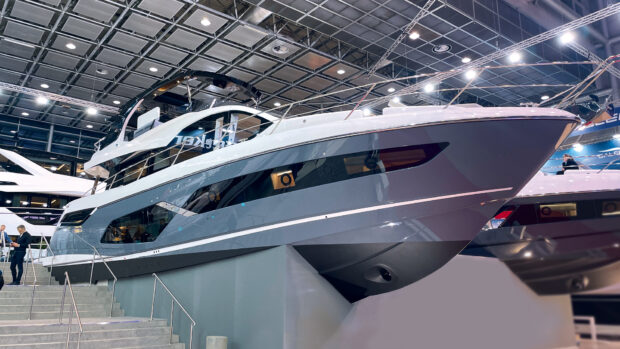Donald and Marjorie Walker are boating across Europe in their Broom 33 to attend an owners’ meeting in Amsterdam
After nine days cruising north on the Saône and Vosges canal, we had reached the French town of Toul, completing stage one of our passage to Naarden in the Netherlands. There we planned to join a gathering of Broom owners in 18 days’ time, meaning we were under some time pressure. However, friends had spoken warmly of the attractions of Toul so I reckoned we could afford to take a day out of our schedule to explore it.
Part of my interest was in the history of the town as a vital link on France’s canal network. This part of the Moselle was only made navigable in 1979 and for more than 100 years before that, all traffic from France and Belgium to the province of Lorraine had to pass through Toul and onwards by canal to Nancy. While poor Marjorie caught up on the laundry at the well-appointed marina, I took the opportunity to explore the now abandoned canal and inspect relics of the old industrial port.

La Strega safely moored in Luxembourg’s Schwebsange Marina. Photo: Donald Walker
In the afternoon we visited the 11th century cathedral, taking the opportunity to stock up on French wine, cheese and other delicacies in the market. I also spent some time planning our route from here, now that we were entering unfamiliar territory.
Boating across Europe: Researching the onwards route
For our travels in France, we have always relied on a range of excellent waterways guides. For the Moselle and the Rhine, we had only been able to find a couple of basic charts showing the routes, place names and distances. The information was all in German and did not include anything about marinas or other moorings.
From talking to friends who had travelled both rivers, I gathered that it was essential to identify secure stopping places each night. It was not safe to moor by the bank and there were relatively few proper marinas where we would be protected from the wash of passing commercial craft.

Mooring bow-first in Metz. Photo: Donald Walker
Based on this, I had drawn up a list of possible overnight stops and places of interest, taking account of the distances we might expect to cover each day. From Toul the recommendation was to head for Pont-à-Mousson about 45km downstream. However, if we could manage another 30km, we would reach Metz, the last major town in France, and a place I particularly wanted to explore.
With that in mind, I got everything organised for an early start the next morning, only to discover as I was about to cast off, that the locks to
get out of town did not open till 9am. This meant that, despite my best efforts, it was already 10am by the time we reached the river.
Article continues below…

French canal boating: What we learned from hiring a boat on the Canal du Midi

Dutch cruising guide: Exploring the nether-Netherlands
Motoring to metz
As we approached our first Moselle lock of the day, just 6km downstream, we saw it standing open as if waiting for us. There was a boat already there and we were surprised to recognise it as the yacht that had set off 36 hours before us.
As we moved into the lock beside them, they told us they had been stuck for two days because the locks between here and Pompey were closed for annual maintenance so they had spent two nights moored on the canal bank. How lucky that we had unwittingly made use of that time to visit Toul.
The section between Toul and Pompey is particularly interesting. The river here was only opened for traffic when the German Moselle was enlarged to Rhine barge dimensions in the 1970s. It took us through picturesque countryside, with traces of the original canal to Nancy still visible on the left bank.

Minimal traffic on the new canalised Moselle heading north from Toul. Photo: Donald Walker
The aqueduct, which had carried the old canal across the river, was sadly long gone but amongst all the evidence of modern engineering, our attention was caught by a beautiful old stone viaduct carrying the railway over the river. We could not help wondering how this Victorian-era structure had somehow survived all the wars and the navigation improvements of the 20th century.
Traffic was very light and by lunchtime we had covered 25km and passed through three locks. We were now looking at just four more locks and another 50km to Metz. There was no barge traffic, presumably a result of the 10 days closure, so I started to think we could do it.
Soon after 3pm we passed Pont-à-Mousson, our original overnight stop. It looked an attractive town with an impressive river frontage but the prospect of having an extra day to explore Metz was more than adequate consolation.

The Moselle valley near Contz Les Bains lives up to its reputation as one of Europe’s prettiest rivers. Photo: Donald Walker
Roman relics
We were now cruising meandering stretches of river and lakes in a wide valley, and as we neared Metz we came upon the highlight of our day, the remains of a Roman aqueduct. Originally of 110 arches, it was not as high as the more famous Pont du Gard in Southern France but it was longer and equally impressive.

Roman remains beneath the Metz museum. Photo: Donald Walker
I saw from the chart that we should now be close to a branch off the main river, an old arm which would lead to Metz. As I turned into the channel, I found it opened into a wide expanse of water more like a lake than a river, with a line of buoys showing us which way to go.
I quickly learned I needed to keep close to these navigation marks as any slight deviation provoked an immediate reprimand from the echo sounder. Unfortunately, on this summer evening there were lots of small hire boats meandering around in front of us, unaware that we had no space to take avoiding action.
We picked our way between the little boats till we reached the Yacht Club, a few pontoons on the far bank, below the town. I spotted a space close to the shore and other boaters kindly came out to take our ropes as we backed in. Unfortunately, due to a tricky cross wind, there was simply not enough room to get
La Strega lined up so, rather than risk damage, I reluctantly gave up that space and moved round to the other side of the pontoon where I could better control my approach, nose into the wind.

The 13th Century German Gate. Photo: Donald Walker
It was now 6.40pm, a rather long day, but worth the effort because having covered 75km and 10 locks, we could afford to spend tomorrow exploring Metz. But for now, it was time for drinks on deck, watching the sun go down, and dining aboard.
Magnificent Metz
Friday morning was windy with the threat of showers but fine for exploring the town. Our starting point was the magnificent 16th century Gothic cathedral, at the
heart of the old city, but as we wandered further out, we discovered just how strong the German influence was. To the north, outside the ancient town wall, is a 13th century fortification known as the German Gate.
There is more modern evidence of German occupation in the architecture of that part of town, including a very fine 1890s vintage railway station building, where we had a delicious lunch.

Impressive remains of the Roman aqueduct near Metz. Photo: Donald Walker
We rounded our day off with a visit to the museum, which is built over Roman remains on display in the basement. As you climb from there the museum gives an excellent chronological picture of the city’s history through the ages.
We had walked a long way, so it was a pleasure to relax and dine on board again that evening, as we prepared for another early start on Saturday morning. We were planning to reach Luxembourg the following day, having been advised by a German friend that we ought to stop at the marina there, perhaps most importantly because Luxembourg was at that point the cheapest place in Europe to buy diesel.
Lucky in Luxembourg Rising at 7.30am, after a remarkably cold night, I spotted our neighbour, in a Dutch-flagged boat, getting ready to leave. Learning that he was heading in our direction I decided to follow him, as having another boat to share the locks with was likely to speed progress.
It turned out that our companion knew this stretch of the river very well and he guided us towards a smaller channel with two original French 38m locks, which bypassed the new giant ones. These we could operate ourselves and with no worries about commercial traffic, we were able to work through them quickly.

Working through the smaller locks outside Metz with a Dutch vessel. Photo: Donald Walker
For the third lock, Richemont, we were back in the 172m locks and here we met our first Rhine-sized barge, working upstream. I feared that now we were starting to see commercial traffic, we might suffer delays at the four remaining locks between here and Luxembourg. However, as the first of these came into view, we caught up with a barge going our way, and happily there was room enough for our two small craft at the back of the lock.
From here on, we simply tucked in behind the barge, content to follow at 10kmh. We were able to relax and enjoy the countryside, which was mainly agricultural, with one big port at Thionville. We were beginning to wonder when we were going to see the grape vines for which the Moselle Valley is famous.
Making steady progress, it was 2pm as we approached Apach, where we joined the Moselle. This was the last lock in France and marked the border crossing. From here for the next 40km, we would have Luxembourg on our port side and Germany to starboard.

Departing Toul on the old canal. Photo: Donald Walker
We were now just 6km from Schwebsange, the only marina in Luxembourg and the recommended re-fuelling point. We had motored just over 500km since filling up in Saint-Jean-de-Losne, and while the gauges were not quite showing empty, I wouldn’t have wanted to go much further. I also reckoned that by re-fuelling now, we should comfortably make it to Holland without having to buy diesel again.
Just 30 minutes later we spotted the arrivals pontoon on our left, with a substantial marina protected by an embankment behind. Pulling up, I allowed myself a smile of satisfaction that we had reached the halfway point of our journey on schedule.
Diesel discount
I set off to find the harbourmaster and secured a berth for the night. Everything was going so well until I said that we needed fuel, only to be told that, unfortunately, the fuel pump closed at 2pm on Saturdays!

AIS gives advance warning of approaching barges. Photo: Donald Walker
I sat down and explained our situation, as calmly as I could manage. I think what may have swung it was telling him we needed at least 400 litres. For that quantity he agreed to open up the fuel berth and serve us himself. I was slightly embarrassed, though pleasantly surprised, when it transpired we only had room in our tank for 328 litres but if he was disappointed, he didn’t show it.
At €1.78 per litre, the price was the best I had seen that season, so I was well pleased with the outcome. Business completed and boat safely moored, I was keen to do some exploring, conscious that we would only be spending this single night in Luxembourg.
As we crossed the border, I had noticed a little village called Schengen. The name seemed to ring a bell with me, and I was interested to find out more. I set off cycling through pleasant countryside, passing a few farms and a couple of riverside campsites. On distant hillsides rising from the edge of the flood plain, I caught my first sight of the famous Moselle vineyards.

:Apach lock that marks the border between France, Germany and Luxembourg. Photo: Donald Walker
Reaching the border village, I found a notice saying that Schengen was the place where in 1985, representatives of the six founding nations of the EU, came together to sign the agreement allowing border free travel within their customs area. Given that we would be passing through five countries and four border crossings on this trip alone, I was very grateful for their efforts.
Sadly, there was little else to see in Schengen, only a few shops aimed at tourists like me. But since we were in Luxembourg, I took the opportunity to buy a few bottles of wine at prices unlikely to be matched in Germany or Holland.
Promising progress
As we relaxed over dinner at the marina restaurant, Marjorie and I reflected on our progress to date. We began our journey 13 days ago and still had 13 days until the start of the Naarden event.
Our boat was performing faultlessly and the rate of travel on the Moselle had been better than anticipated. We had already covered around a third of the distance to Koblenz, so were confident we could reach the Rhine within the next five days. Allowing for five more to the Netherlands, we should have three days in hand for rest breaks, exploring or unexpected problems.

Following a friendly barge sped up the passage through the locks. Photo: Donald Walker
On the other hand, we still had 650km to go, including the infamous Rhine with its strong current and fast-moving barges. Thankfully, that was still a while off and we had the rest of the Moselle to look forward to, one of the prettiest rivers in Europe.
Next month Donald and Marjorie take in the sights of the Moselle with its famous vineyards, castles and luxury cruise ships.
 If you enjoyed this….
If you enjoyed this….
Motor Boat & Yachting is the world’s leading magazine for Motoryacht enthusiasts. Every month we have inspirational adventures and practical features to help you realise your sailing dreams, as well as tests and news of all the latest motorboats.
Plus you’ll get our quarterly Custom Yachting supplement where we share the last on offer in the superyacht world and at the luxury end of the market.
Build your knowledge with a subscription delivered to your door. See our latest offers and save at least 30% off the cover price.




 If you enjoyed this….
If you enjoyed this….





